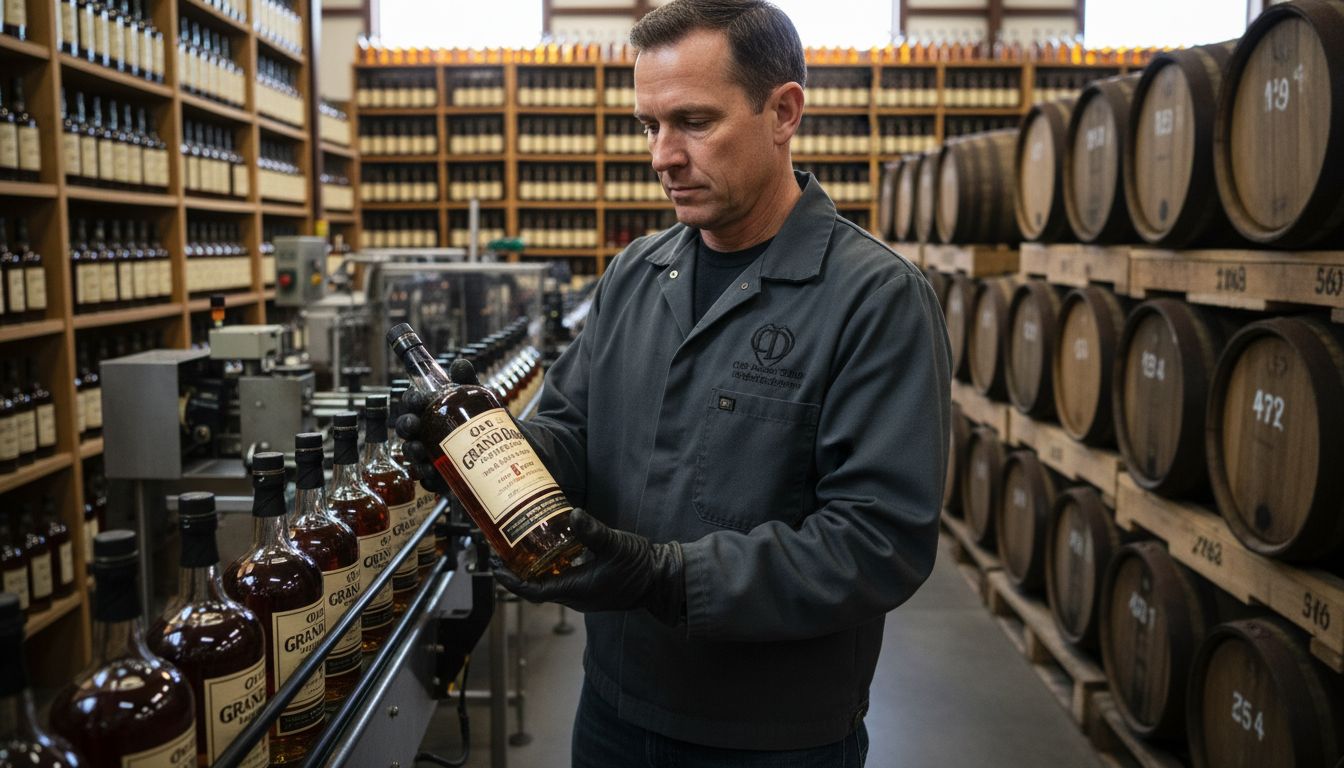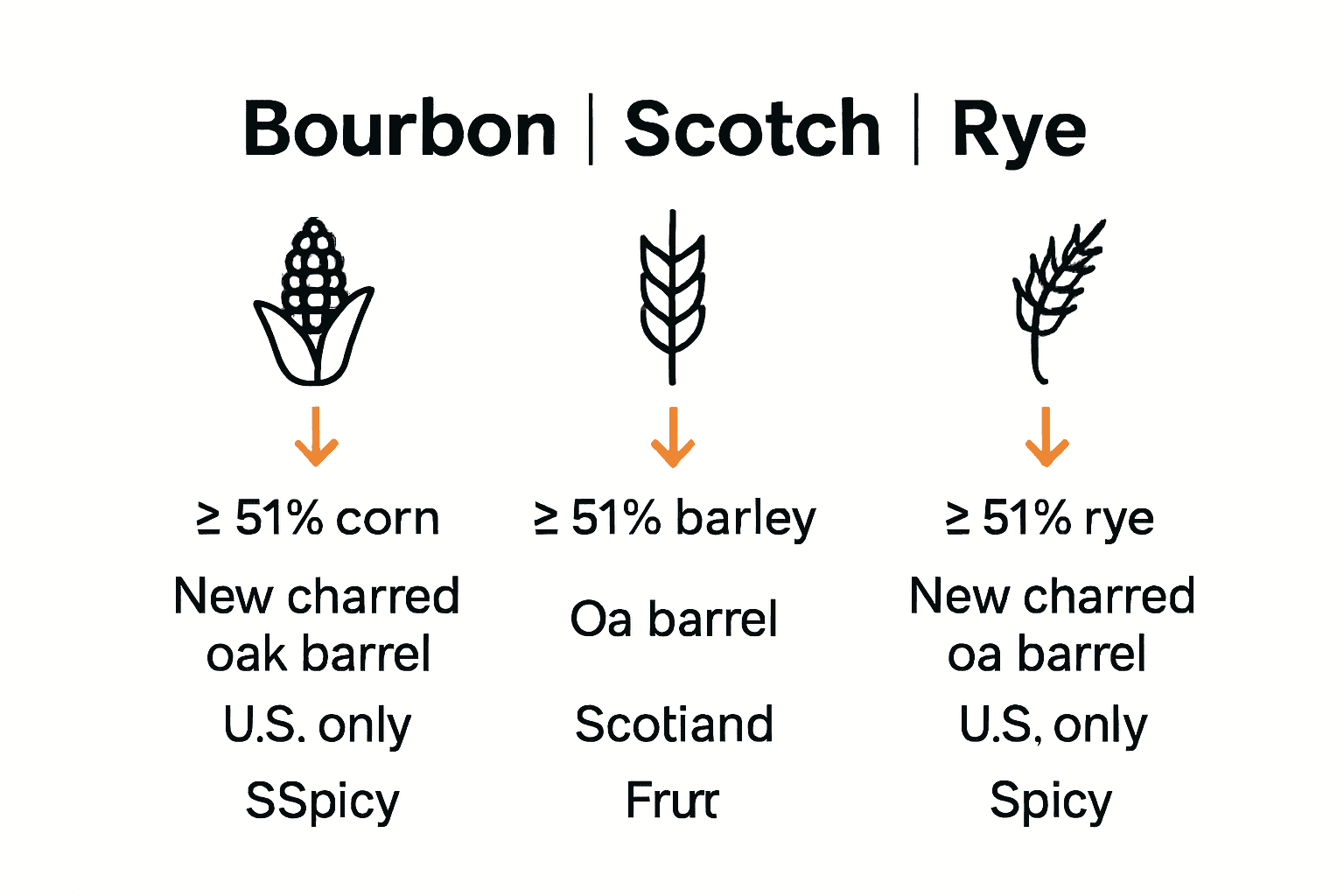Most people are surprised to learn that federal law requires bourbon to be made from at least 51 percent corn and aged in new charred oak barrels. These rules do more than define a famous American spirit—they protect the unique taste and rich history in every bottle. Understanding what truly sets bourbon apart helps both beginners and seasoned fans separate fact from fiction, making every pour more interesting and enjoyable.
Table of Contents
- Defining American Bourbon And Common Misconceptions
- Legal Standards And Production Requirements
- Flavor Profiles And Key Characteristics
- Aging, Bottling, And Labeling Practices
- Bourbon Versus Other Whisky Types
Key Takeaways
| Point | Details |
|---|---|
| Legal Definition of Bourbon | Bourbon must be distilled from at least 51% corn and aged in new charred oak barrels in the U.S. to be legally classified as such. |
| Common Misconceptions | Bourbon can be produced in any U.S. state, and it is not uniform in flavor; variations exist due to differences in grain composition and aging. |
| Production Standards | The spirit must be distilled to a maximum of 160 proof, entered into barrels at no more than 125 proof, and bottled at a minimum of 80 proof. |
| Flavor Characteristics | Bourbon typically exhibits a sweet taste from the corn, with notes of vanilla, caramel, and unique spice elements influenced by the mash bill and aging process. |
Defining American Bourbon and Common Misconceptions
American bourbon represents a distinctive whiskey style with precise legal requirements that set it apart from other spirits. Bourbon is not just another whiskey - it’s a carefully regulated product with specific production standards defined by federal regulations. According to Cornell Law, bourbon must be distilled from a fermented mash containing at least 51% corn, with strict guidelines governing its production process and ingredients.
The legal definition of bourbon extends beyond mere ingredients. Government Info clarifies that authentic bourbon must be produced exclusively within the United States and aged in new charred oak containers. These requirements ensure a consistent quality and unique flavor profile that distinguishes bourbon from other whiskey varieties.
Several common misconceptions persist about bourbon that merit clarification. Many people mistakenly believe that bourbon must be produced in Kentucky, which is incorrect - while Kentucky produces exceptional bourbon, the spirit can legally be crafted in any U.S. state. Another widespread myth suggests that all bourbons taste identical, when in reality, subtle variations in corn percentage, aging time, and barrel characteristics create remarkable diversity in flavor profiles.
Key characteristics that define authentic bourbon include:
- Minimum 51% corn in the mash bill
- Distilled to no more than 80% alcohol by volume
- Aged in new charred oak containers
- Produced exclusively in the United States
- No additional flavoring or coloring permitted
Understanding these precise requirements helps whisky enthusiasts appreciate the craftsmanship and legal precision behind every exceptional bourbon.
Legal Standards and Production Requirements
The legal framework surrounding bourbon production is intricate and stringent, ensuring that only spirits meeting precise specifications can bear the bourbon designation. Cornell Law provides detailed regulations specifying that bourbon must be distilled to no more than 160 proof, entered into aging barrels at no more than 125 proof, and ultimately bottled at a minimum of 80 proof. These technical requirements are designed to maintain the integrity and quality of bourbon as a distinct American spirit.
Beyond proof specifications, additional legal standards govern bourbon’s production process and labeling. Cornell Law mandates that any bourbon aged less than four years must include a clear age statement on its label, providing transparency for consumers. Furthermore, the regulations strictly prohibit the addition of flavoring or coloring agents, preserving bourbon’s authentic character and preventing manufacturers from artificially manipulating the spirit’s appearance or taste.
The production journey of bourbon is carefully controlled from grain selection to bottling. Distillers must start with a mash bill containing at least 51% corn, which contributes to bourbon’s distinctive sweetness. The remaining grains typically include malted barley and either rye or wheat, each influencing the final flavor profile. New charred oak barrels are mandatory for aging, with each barrel used only once - a requirement that significantly impacts the bourbon’s color, aroma, and taste.
Key legal production requirements include:
- Minimum 51% corn in the mash bill
- Distilled to maximum 160 proof
- Entered into barrels at maximum 125 proof
- Bottled at minimum 80 proof
- Aged in new charred oak containers
- No artificial coloring or flavoring permitted
- Mandatory age statements for bourbons aged less than 4 years
These exacting standards transform bourbon from a simple whiskey into a meticulously crafted spirit with a proud American heritage.

Flavor Profiles and Key Characteristics
Bourbon offers a complex sensory experience that distinguishes it from other spirits, characterized by a rich and nuanced flavor profile deeply rooted in its production methods. The mandatory use of corn as the primary grain creates a foundational sweetness, while the new charred oak barrels impart distinctive notes of vanilla, caramel, and subtle woody undertones. Each bourbon presents a unique flavor journey, influenced by variations in mash bill composition, aging duration, and specific distillation techniques.
PubMed research suggests that while individual bourbons demonstrate remarkable sensory diversity, the categorical differences between bourbon and other whiskey styles can be surprisingly subtle. This complexity emerges from several critical factors that shape the spirit’s character, including grain selection, fermentation processes, and barrel interaction during aging.
The corn-based mash bill typically produces a sweeter flavor profile compared to other whiskey varieties. Depending on the additional grains used, bourbon can range from soft and smooth to bold and spicy. Rye-heavy mash bills tend to introduce peppery notes, while wheat-based bourbons offer a softer, more delicate drinking experience. The charred oak barrel’s interior contributes crucial flavor elements, releasing compounds that create deep caramel, vanilla, and toasted wood characteristics.
Key flavor characteristics of bourbon include:
- Predominant corn sweetness
- Vanilla and caramel undertones
- Woody and oak-derived notes
- Potential spicy or peppery hints
- Smooth or robust mouthfeel
- Lingering warm finish
Understanding these flavor nuances transforms bourbon from a simple alcoholic beverage into a sophisticated sensory exploration of American craft distillation.
Aging, Bottling, and Labeling Practices
Bourbon aging represents a meticulous process that transforms raw spirit into a complex, nuanced beverage. Cornell Law mandates that bourbon must be aged in new charred oak barrels, a requirement that fundamentally shapes the spirit’s character. These virgin oak containers are used only once, ensuring that each barrel imparts maximum flavor complexity and rich amber coloration to the whiskey during the aging process.
Labeling regulations for bourbon are equally stringent and designed to provide transparency for consumers. Cornell Law stipulates that any bourbon aged less than four years must include a clear age statement on its label, preventing manufacturers from obscuring the spirit’s maturation period. Additionally, the regulations strictly prohibit the addition of artificial flavoring or coloring agents, preserving bourbon’s authentic essence and protecting consumers’ expectations of a pure, unadulterated spirit.
The bottling process represents the final critical stage in bourbon production, with precise alcohol content requirements governing the final product. Distillers must carefully balance the spirit’s proof, ensuring it meets the minimum 40% alcohol by volume standard while maintaining the desired flavor profile. Some premium bourbons are bottled at higher proofs, offering more intense flavor experiences for discerning whiskey enthusiasts. The interaction between barrel, time, and craftsmanship determines the ultimate quality and character of each bourbon.
Key aspects of bourbon aging and bottling include:
- Mandatory new charred oak barrel aging
- Single-use barrel requirement
- Minimum 4-year aging for label-free products
- No artificial flavors or colors permitted
- Minimum 40% alcohol by volume
- Precise labeling of age statements
Learn more about whisky aging processes in our comprehensive guide on why whisky is aged, which provides deeper insights into the intricate world of spirit maturation.
Bourbon Versus Other Whisky Types
Whisky classification represents a complex landscape of distinctive spirits, with bourbon occupying a unique position within this diverse family. Cornell Law provides clear legal distinctions, specifically defining bourbon as a whiskey that must be distilled from a mash containing at least 51% corn, fundamentally differentiating it from other whiskey varieties like rye, which requires a minimum of 51% rye grain in its mash bill.
PubMed research reveals an intriguing nuance in whiskey categorization, suggesting that despite precise legal definitions, sensory analysis struggles to consistently differentiate between bourbon and other whiskey categories. This scientific insight challenges the traditional perception that each whiskey type presents an entirely distinct drinking experience, highlighting the subtle complexities within spirit production.
The primary distinctions between bourbon and other whisky types extend beyond grain composition. Scotch whisky, for instance, is typically made from malted barley and must be produced in Scotland, while Canadian whisky allows more flexible grain combinations. Japanese whisky often emulates Scottish production methods, creating a different flavor profile compared to the sweet, corn-forward characteristics of American bourbon. Each whiskey style reflects its cultural and geographical origins, with bourbon representing a quintessentially American spirit characterized by its corn base and strict production regulations.
Key differences between bourbon and other whisky types include:
- Minimum 51% corn requirement for bourbon
- Mandatory new charred oak barrel aging
- United States production location
- Distinct legal production standards
- Unique flavor profile driven by corn mash
- No artificial additives permitted

Learn more about the nuanced differences between whisky varieties in our comprehensive guide, which explores the rich tapestry of global whisky production.
Discover Authentic American Bourbon with Confidence
If you have come to understand the exacting standards and rich heritage behind American bourbon you might be eager to explore these unique flavours firsthand. Knowing that every bottle must have at least 51% corn and age in new charred oak barrels sharpens your appreciation for what makes bourbon special. However it can be challenging to find premium bourbon selections that meet these criteria and suit your tasting preferences.
At Uisuki.com.au we take the guesswork out of choosing authentic American bourbon by offering a curated range that puts legal standards and flavour profiles right at the centre. Whether you seek a sweet corn-forward dram or something with a richer vanilla and caramel complexity you will find options crafted with care and fully compliant with regulations. Explore our collection of American Whiskey – Uisuki.com.au to embrace true American craftsmanship.

Ready to elevate your bourbon experience? Dive into our expertly selected bottles now and experience the proud heritage and nuanced flavour that defines authentic American bourbon. Browse our range today and discover your next favourite whisky. For a broader perspective on whisky, check out our Older Bottling’s – Uisuki.com.au or start at the Uisuki homepage for more exclusive whisky opportunities.
Frequently Asked Questions
What is American bourbon?
American bourbon is a type of whiskey made primarily from corn, with at least 51% corn in its mash bill. It must be distilled in the United States and aged in new charred oak containers, following strict legal guidelines.
How is bourbon different from other types of whiskey?
Bourbon differs from other whiskey types primarily due to its mash bill composition, which requires at least 51% corn. Additionally, bourbon must be aged in new charred oak barrels and produced in the United States, while other whiskeys may have different grain requirements and aging practices.
What are the key flavor characteristics of bourbon?
Bourbon typically features a rich sweetness from the corn, along with flavors of vanilla, caramel, and woody notes from the charred oak barrels. Some bourbons may also have spicy or peppery hints, depending on the grain composition used in the production.
Why is aging important for bourbon?
Aging bourbon in new charred oak barrels is crucial because it enhances the spirit’s flavor profile, adding complexity and depth. This process allows the bourbon to develop distinctive notes from the wood, affecting its color, aroma, and overall taste. Additionally, labeling regulations require bourbons aged less than four years to display an age statement, ensuring transparency for consumers.

